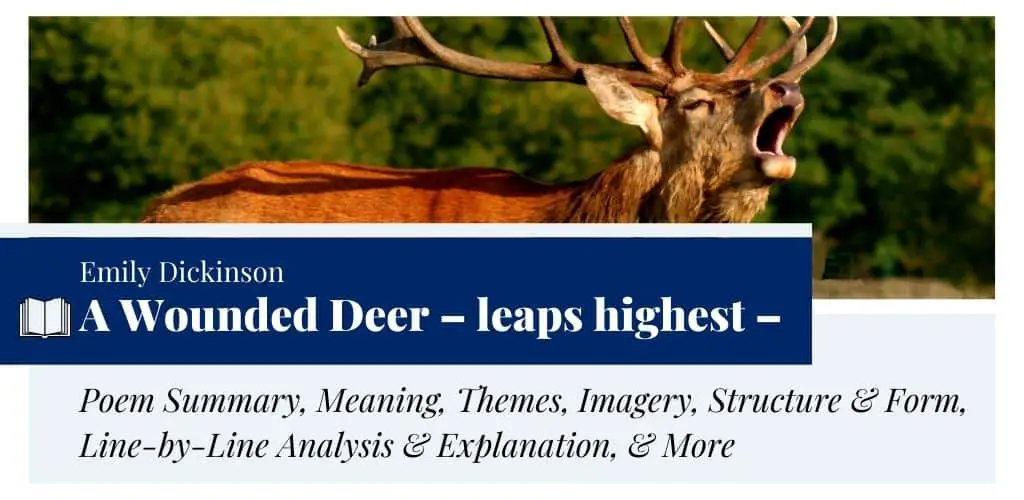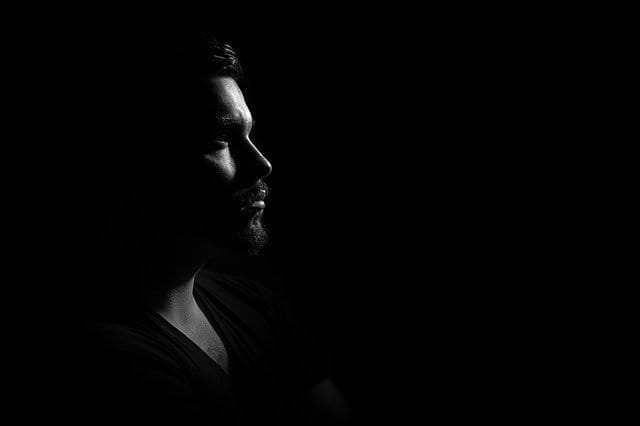A Wounded Deer – leaps highest – by Emily Dickinson
Emily Dickinson’s poem “A Wounded Deer – leaps highest –” was published posthumously in 1890 in Poems, the first compilation of her poetry. It begins with an image of a deer shot by a hunter, putting on an appearance of being strong as it leaps the highest before dying. However, the poem has a deeper meaning that is conveyed cleverly through the use of figurative language, strong verbs, and adjectives. It is a layered poem rich in imagery, metaphor, paradox, and other literary techniques.
- Read the full text of “A Wounded Deer – leaps highest –” below:
A Wounded Deer – leaps highest – by Emily Dickinson A Wounded Deer – leaps highest – I've heard the Hunter tell – 'Tis but the Ecstasy of death – And then the Brake is still! The Smitten Rock that gushes! The trampled Steel that springs! A Cheek is always redder Just where the Hectic stings! Mirth is the Mail of Anguish – In which it Cautious Arm Lest anybody spy the blood And, “you're hurt” exclaim! - from Poems (1890)

Summary
“A Wounded Deer – leaps highest –” begins with hearsay from a hunter that a deer that is shot takes the highest leap before finally collapsing to death. The deer takes its highest leap after being fatally wounded before falling dead in the thicket. It is a metaphor for people hiding their emotional distress hiding behind their appearance of normalcy.
Dickinson continues to make various analogies in the subsequent stanzas. She uses a biblical allusion to Moses, who strikes the rock in Horeb and water gushes out of it upon Lord’s instruction. Similarly, a steel trap springs after being trampled. Alongside that, a terminally ill person’s cheek reddens, making them appear healthy and full of life which can be deceiving.
People often prevent their anguish from being manifested by hiding it behind a façade of “Mirth” and joy. They do not let their guard (chain mail) down to protect their vulnerability even though they are hurt.
Meaning
Dickinson’s lyric “A Wounded Deer – leaps highest –” begins with reference to a “Wounded Deer,” which leaps the highest in pain. The speaker describes its final lear as the “Ecstasy of death.” It is comparable to a dramatic act. The intensity of actions increases and reaches an optimum level at the climax. Likewise, any living creature tries their best when they are dying or in a similarly dire state. In the second stanza, the speaker shifts her focus from death to the fatal blow. Here, the speaker describes how life shows most of its vitality just a moment before the metaphorical “Hectic” inserts the final sting. Dickinson talks about how appearances can be deceptive under specific circumstances in the final stanza.
Form, Rhyme Scheme, & Meter
Dickinson’s “A Wounded Deer – leaps highest –” consists of 3 stanzas of 4 lines each. A stanza consisting of four lines is called a quatrain. The poem follows a seemingly regular rhyme scheme, ABCB. To frame the text in this scheme, Dickinson uses slant rhymes as in “tell” (line 2) and “still” (line 4). Although the second and fourth lines of each stanza seem to rhyme, they are not perfect rhymes.
Besides, the poem is written in iambic trimeter with a few variations. For instance, the third lines of the first and third stanzas are in iambic tetrameter. Dickinson uses trochees at the beginning of lines 8, 9, 11, and 12 to make readers halt and emphasize the ideas. Let’s have a look at the scansion of the poem to have a better understanding of the metrical scheme.
A Wound/-ed Deer/ – leaps high(e)st –
I’ve heard/ the Hun/-ter tell –
‘Tis but/ the Ecs/-ta-sy/ of death –
And then/ the Brake/ is still!
The Smit/-ten Rock/ that gush(e)s!
The trampl/-ed Steel/ that springs!
A Cheek/ is al/-ways redd(e)r
Just where/ the Hec/-tic stings!
Mirth is/ the Mail/ of Anguish –
In which/ it Cau/-tious Arm
Lest a/-ny-bo/-dy spy/ the blood
And,/ “you’re hurt”/ ex-claim!
Poetic Devices
Dickinson makes use of the following poetic devices in her poem “A Wounded Deer – leaps highest –”.
- Paradox: Dickinson uses contradictory ideas that reveal a more profound meaning upon reflection. In the phrase, “Ecstasy of death,” the contradictory ideas of happiness and death are used. Moments before dying, the deer gathers all its strength to take one last giant leap, which is filled with excitement instead of crying out and surrendering to pain.
- Juxtaposition: The poet uses contradictory words and places them in a line to create comparison and contrasting effects. For instance, in the line, “Mirth is the Mail of Anguish,” contradictory ideas of merriment and severe pain are used. It is to emphasize how mirth masks the contradictory feeling of anguish.
- Metaphor: Dickinson’s mastery in the clever use of metaphors is evident in this poem. For instance, the biblical allusion of Moses’ “Smitten Rock” refers to a broken person in distress. The water that gushes out of the smitten rock is a symbol of life and rejuvenation. Likewise, the poet conveys the idea that a broken person has the ability to release their pain and cling to life before yielding to death.
- Alliteration: This device is used in the poem to give it a sense of internal rhythm. It occurs in “heard the Hunter,” “Steel that springs,” and “where the Hectic,” etc.
- Consonance: In the line, “Mirth is Mail of Anguish,” the sound of “m” is repeated for the poetic effect. It also occurs in other instances.
- Symbolism: The poet employs rich symbolism in the poem. “Wounded Deer,” “Smitten Rock,” and “trampled Steel” refer to a person bearing emotional wounds. Through each symbol, the poet makes references to the human experiences of suffering and pain.
- Personification: It occurs in the lines, “And then the Brake is still,” “The Smitten Rock that gushes,” “The trampled Steel that springs,” and “Just where the Hectic stings.” In these lines, Dickinson personifies abstract ideas such as “Hectic” and inanimate objects such as “Brake,” “Steel,” etc.
Line-by-Line Analysis & Explanation
Lines 1-4
A Wounded Deer – leaps highest –
I’ve heard the Hunter tell –
‘Tis but the Ecstasy of death –
And then the Brake is still!
Dickinson’s poem “A Wounded Deer – leaps highest –” begins with the image of a deer that has been suffering from a fatal wound. Instead of slowing down the deer, the wound makes it take the highest leap before falling dead in the brake (bush or thicket). In the third line, “Ecstasy of death” contains a paradox. It refers to the idea that the deer musters all its strength to take one last leap of life instead of decelerating and despairing about the wound.
This poem imparts the idea that however strong or joyful people may appear, they could be broken or wounded from within. They put on a façade of normalcy so that they appear happy. Their facial expressions do not let people permeate the depths of their pain and recognize their vulnerability, just like the “Wounded Deer.”
Lines 5-8
The Smitten Rock that gushes!
The trampled Steel that springs!
A Cheek is always redder
Just where the Hectic stings!
In the second quatrain, Dickinson discontinues the imagery of the “Wounded Deer” and the “Hunter.” Here, she uses an allusion to a biblical episode where Moses was told by God to strike the rock in Mount Horeb to provide water to the thirsty Israelites. He struck the rock upon God’s instruction, and water gushed out of it quenching their thirst.
Water is regarded as a symbol of life. People who are hurt or carrying hidden wounds often do exceptional things. People struck by anguish or pain have the capability to transform their pain into something remarkable. Here, Dickinson strikes a personal chord regarding her inspiration behind writing poetry, hidden pain, and insurmountable loneliness.
The second line, “The trampled Steel that springs,” communicates the idea that the steel trap comes into life and force when compressed by another object or thing. An individual who suffers humiliation or is trampled by others eventually overcomes it and springs back to life. Like the trap, they fight and bite back, resulting in a fatal, life-threatening blow.
The archaic definition of “Hectic” is fever or other serious illness such as Tuberculosis. In the last two lines of this stanza, the speaker says that the “Cheek” (a use of synecdoche: the speaker refers to a person as a whole) that reddens due to fever or illness look similar to the red cheeks of a perfectly healthy and lively person. It means that a person’s body, overcome with illness, puts on a healthy appearance. The rosy cheeks make them appear more lively and joyful. In reality, it signals impending death. In this way, Dickinson depicts how the colors of life and vitality (red) can be deceiving in specific circumstances.
Lines 9-12
Mirth is the Mail of Anguish –
In which it Cautious Arm
Lest anybody spy the blood
And, “you’re hurt” exclaim!
In the first line of this section, the term “Mirth” means merriment or cheerfulness. This line describes how a person prevents the anguish from revealing itself with a veiled smile. “Mirth” is like chainmail which is body armor that protects knights from being wounded. This metaphorical line echoes the aphorism: one should wear one’s weakness as a shield/defense; thus, none can use it against them.
The image of the chainmail corresponds to people hiding their pain behind their cheerful appearance. They do not let their guard down and let themselves be vulnerable to the people around them. According to the speaker, mirth is used as an arm of caution lest anyone else spy the “blood,” a metaphorical reference to one’s weakness. No matter how much one is hurt, one cannot “exclaim” their genuine emotions publically. Thus the last line contradicts the aphorism: always be true to yourself.
Imagery
The poet’s use of vivid imagery helps one to conjure the idea the speaker tries to convey. In this poem, the image of a deer being shot and wounded, for instance, allows one to sympathize with the pain of the deer. They can relate to the deer’s efforts in appearing to be strong and ecstatic despite being wounded. The vivid use of organic imagery helps one to explore much deeper meaning beyond the literal meaning by making one feel the happenings in the world Dickinson creates in this poem.
Apart from that, she uses kinesthetic imagery in the lines, “And then the Brake is still!” and “The trampled Steel that springs!”. There is a use of visual imagery in the lines, “A Cheek is always redder/ Just where the Hectic stings!” and “Lest anybody spy the blood.”
Themes
Appearance vs. Reality
The central theme of “A Wounded Deer – leaps highest –” is that of people putting on a façade of joy and strength despite being hurt from within. People often hesitate to reveal their emotional wounds because of the fear of being judged or humiliated. The pent-up anguish within them is staged as an acceptable appearance of cheerfulness. In this way, Dickinson taps on one of the best-known themes in literature, appearance versus reality.
Transformation of Pain into Strength
Life struggles can increase an individual’s threshold to endure pain. Past experiences can make one capable of transforming their anguish into something exceptional. Often, people who are hurt from within can achieve remarkable feats. Like the Deer, which gathers all its strength and performs its final leap, human beings make their best effort in desperate times.
Death
Most poems of Dickinson deal with the theme of death and the afterlife. In this poem, she explores her paradoxical feelings associated with dying. Death has a literal as well as figurative meaning in the text. The Deer in the poem dies literally. However, it is also a metaphor for people fighting from within as a result of being emotionally wounded. Though the poem overtly depicts desperation, it is about the last ordeal in which humans put their best in order to defeat death.
Historical Context
Emily Dickinson is one of the most remarkable American poets of all time. Along with Walt Whitman, she is considered one of the most important figures of 19th-century American literature. For the most part of her life, Dickinson lived in seclusion. She mostly communicated with her friends through letters. She expressed herself in her poems and maintained limited contact with society. Unlike other poets of her era, she broke the chains of the conventional form of poetry and experimented with different styles and genres.
Most of Dickinson’s poems deal with macabre themes like death, afterlife, and immorality, while some explore themes such as love, aesthetics, nature, and spirituality. Dickinson was not recognized during her lifetime as only 10 of around 1,800 of her poems were published. It was after her death in 1886 that her sister Lavinia discovered her treasured poems and published them thereafter.
Her first collection of poetry, Poems, was published in 1890. The poem “A Wounded Deer – leaps highest –” appears in Book I (entitled “Life)” of this collection. In Thomas H. Johnson’s Complete Poems (1955), it appears as the 165 number poem. According to Johnson, this poem was written around 1860. During this time, Dickinson collected her poems in the small hand-sewn books called fascicles.
Questions & Answers
This aphorism was coined by the American poet Emily Dickinson. It is the first line, “A Wounded Deer – leaps highest –” of her 165th poem in the collection, The Complete Poems of Emily Dickinson(1955).
Dickinson’s “A Wounded Deer – leaps highest –” is about full-spirited desperation in times of dire need, for instance, while dying. The speaker clarifies this concept with the image of a “Wounded Deer,” which leaps the highest before finally collapsing to death.
This line depicts how a deer leaps in agony after being fatally shot. It jumps by collecting all its energy and then slowly embraces the coldness of death. The poet uses short dashes to project a transition from caution to action, immobility to activity. Overall, this poem shows how the furtive expressions hide one’s dire condition.
The line “Mirth is the Mail of Anguish” contains the essence of the poem. Thus, Dickinson tweaks the meter and employs internal rhyming of the “m” sound in order to make readers emphasize the terms “Mirth,” “Mail,” and “Anguish.” She also uses capitalization for this purpose. Through this line, the poet compares “mirth” to the chainmail worn by knights. Metaphorically, “Anguish” is the one (use of personification) who wears a mask of “Mirth” as chainmail for protection against criticism and humiliation.
It is an epigrammatic poem that appears to be a simple lyrical piece, but it is multi-layered text. Dickinson makes use of figurative devices and archaic terms in order to convey her message.
It is a lyric poem written in quatrain form. The rhyme scheme of this poem is roughly ABCB like other Dickinson’s poems. The overall poem is composed in iambic trimeter.
The major themes of the poem are the deceptiveness of appearance, the transformation of pain into power, and the macabre theme of death. Through this piece, Dickinson shows how dire situations make humans appear more spirited and happy. Within, they tremble in fear and agony.
The literary devices used in the poem are antithesis or juxtaposition, paradox, imagery, metaphor, alliteration, personification, and symbolism. These devices make the poet’s thoughts more appealing to readers.
The poem roughly follows the ABCB rhyme scheme. The second and fourth lines of the first and third stanzas have slant rhymes, for instance, “tell” and “still.” There is only one instance of perfect rhyme in “springs” and “stings.”
The “Wounded Deer” is a metaphor for a person bearing emotional wounds. Like a fatally shot deer leaping the highest, human beings’ creativity reaches new heights in pain and heartache.
The “Smitten Rock” is an allusion to an episode from the Book of Exodus. In Exodus 17:6, God instructed Moses to strike a particular rock of Mount Horeb, after which water gushed out of it, providing water to thirsty Israelites. The biblical “rock” infused drops of life (water) into the desperate Israelites when it was “smitten” hard. Similarly, one performs miracles when life hits them hard.
Similar Poems about Suffering, Pain, & Death
- “Spring” by Edna St. Vincent Millay — In this poem, Millay describes how the appearance of spring is deceptive as it makes us forget about our troubled past.
- “The Heart asks Pleasure—first—” by Emily Dickinson — This poem explores the human desire to seek pleasure instead of suffering in pain.
- “Root Cellar” by Theodore Roethke — This “greenhouse poem” is about the essence of living that never allows one to surrender, no matter how hopeless their condition is.
- “Death the Leveller” by James Shirley — This piece is all about the nature of death that levels us all irrespective of our social status or virtues.
External Resources
- About the “Smitten Rock” — Read about the most popular typological symbol of the “Smitten Rock” and its religious significance.
- Full text of Poems (1890) — Explore more poems from Emily Dickinson’s first collection of poetry.
- About Emily Dickinson — Learn about the poet’s life and works.
- Biography of Emily Dickinson — Read the full biography of the poet, including summaries of different periods of her life.
- Check out The Complete Poems of Emily Dickinson (1955) — Lovers of Emily Dickinson’s poetry always keep this collection close to their hearts. It contains the unadulterated versions of her texts.






